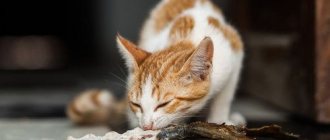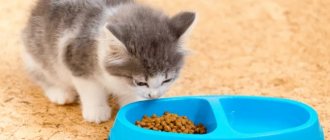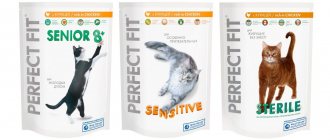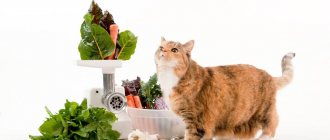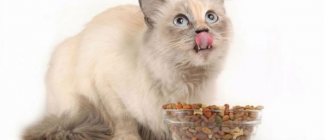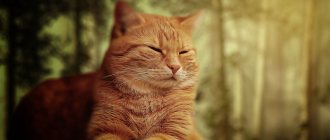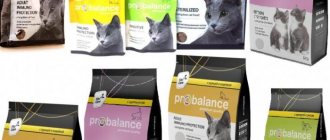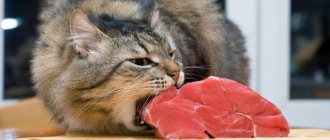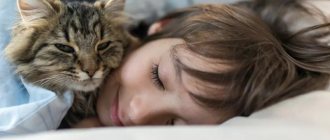The modern rhythm of life leaves its mark on society. People who have pets are forced to feed their four-legged friends dry food. This type of food saves time because you don't have to stand at the stove for hours. However, not everyone knows that dry food is dangerous to the health of cats. They are addictive, poorly absorbed and do not saturate the skin with the elements necessary for full hair growth. Hence the need arises to transfer the animal from ready-made feed to natural food.
How to wean a cat off dry food
Option #1.
You cannot suddenly switch an animal to natural food; some consistency must be observed. Alternate ready-made food with regular food, and the first should be given in the morning, when digestion has just started. Be sure to keep an eye on your cat's drinking bowl; there should always be clean water in it. The grains of dry food swell in the stomach, absorbing liquid, hence the constant thirst. Meals must be provided strictly according to the schedule, the frequency of feeding procedures is 3 times a day. Devote the morning meal to dry food (you can soak it in water), and serve natural food for lunch and dinner.
Option #2.
There is another scheme for transferring a cat from dry food to natural food. It consists of mixing two types of food in certain proportions. On the first and second days, you need to steam the dry food with water, knead it with a fork and mix it with regular food in a 5:1 ratio (5 parts dry food, 1 part natural food). In this case, actions must be performed 3 times a day (every meal). From the third to the fifth day, increase the amount of natural food to two parts, that is, mix it with dry food in a ratio of 5:2. Every few days, add one portion of natural food.
Useful tips
- It is extremely difficult to wean a cat off dry food; they become very accustomed to taste and smell enhancers, preservatives and artificial additives. Of course, this is exactly what manufacturers are counting on. Observe the proportions, take your time, mix in one part every few days, or leave the morning time for feeding with the prepared mixture. It is important to understand that the transition should be smooth, unnoticeable for the pet itself.
- Many cats refuse to eat any food other than dry food. The owners, in turn, begin to starve them, mistakenly believing that the animal will eat everything when it gets hungry. You don't need to do that, be smarter. Arouse interest in natural food with treats; give your cat something tasty every time. He must remember the smell and consistency. Try treating your pet to chicken fillet or pork pulp, banana, potatoes or sausage. It is important to make a start, and then things will go naturally.
- The first thing you need to do is feed your cat the soaked food for two weeks. In this case, the food must be filled with water, left to steep, and then all salts and impurities must be drained. Do not let the animal drink the liquid that remains in the end.
- Next, transfer the cat to ready-made food, but in the form of canned food. Give preference to one manufacturer. Feed the animal a similar treat for a week, then proceed to the next step.
- At this stage, it is necessary to mix natural food into the canned food. For 100 gr. Factory products account for 20 grams. regular food. Feed your pet at this rate for 7-10 days.
- After time, increase the amount to 40 g. per 100 gr. canned food Keep the cat in this mode for about 5 days, then start adding 60 grams. natural food per 100 gr. canned food
- When you reach this point, wait 3 days and try giving your cat all-natural food. If she refuses to eat, add 10 grams. finished product and try again.
- If your pet refuses again, wait a while so that she gets hungry, but don’t delay. Avoid hunger that lasts more than a day.
- In cases where the cat flatly does not want to eat, increase the proportions to 70 g. natural food per 100 gr. canned food, then every day again mix in regular food, but not sharply, add 5 grams.
- The marketing of dry food manufacturers is the same: they present it as a universal product that can replace natural food. At the same time, manufacturers claim that the finished food contains the required amount of proteins, fats, carbohydrates and fiber. They argue this by the percentage of vitamins and elements necessary for the full development of the cat and its future offspring (if the cat is pregnant). Of course, expensive food can boast of this, but not the economy segment.
- An important feature of feeding cats is that meat alone is not enough for them. The animal needs grains, dairy products and vegetables, which are responsible for vision, digestion and strengthening bone tissue. Therefore, when switching from dry food to natural food, you need to give your cat vitamins containing calcium, iron and magnesium. Cook food without adding seasonings, add salt rarely, and if possible, cook without it.
- Unlike cats, cats are prohibited from being given sausage and canned food in oil; onions, garlic, and herbs (dill, parsley) are also contraindicated for them. Experienced veterinarians unanimously say that cats should not be fed raw fish, even if they eat it with pleasure. As for chicken and quail eggs, you can sometimes pamper your pet with the latter option if there is no allergy. Raw meat, namely pork and beef, can cause stool and stomach upset, so they should be fed with caution.
how to remove fleas from a cat at home
How to wean a cat off dry food
how to properly wash a cat
Important aspects
It is easier to wean cats off dry food than cats. Act gradually, do not try to force feed the animal natural food, let him come to this on his own. In cases with cats, add vitamins and minerals to their food and take the course once every six months.
The modern rhythm of life leaves its mark on society. People who have pets are forced to feed their four-legged friends dry food. This type of food saves time because you don't have to stand at the stove for hours. However, not everyone knows that dry food is dangerous to the health of cats. They are addictive, poorly absorbed and do not saturate the skin with the elements necessary for full hair growth. Hence the need arises to transfer the animal from ready-made feed to natural food.
How to wean a cat off dry food
Option #1.
You cannot suddenly switch an animal to natural food; some consistency must be observed. Alternate ready-made food with regular food, and the first should be given in the morning, when digestion has just started. Be sure to keep an eye on your cat's drinking bowl; there should always be clean water in it. The grains of dry food swell in the stomach, absorbing liquid, hence the constant thirst. Meals must be provided strictly according to the schedule, the frequency of feeding procedures is 3 times a day. Devote the morning meal to dry food (you can soak it in water), and serve natural food for lunch and dinner.
Option #2.
There is another scheme for transferring a cat from dry food to natural food. It consists of mixing two types of food in certain proportions. On the first and second days, you need to steam the dry food with water, knead it with a fork and mix it with regular food in a 5:1 ratio (5 parts dry food, 1 part natural food). In this case, actions must be performed 3 times a day (every meal). From the third to the fifth day, increase the amount of natural food to two parts, that is, mix it with dry food in a ratio of 5:2. Every few days, add one portion of natural food.
- It is extremely difficult to wean a cat off dry food; they become very accustomed to taste and smell enhancers, preservatives and artificial additives. Of course, this is exactly what manufacturers are counting on. Observe the proportions, take your time, mix in one part every few days, or leave the morning time for feeding with the prepared mixture. It is important to understand that the transition should be smooth, unnoticeable for the pet itself.
- Many cats refuse to eat any food other than dry food. The owners, in turn, begin to starve them, mistakenly believing that the animal will eat everything when it gets hungry. You don't need to do that, be smarter. Arouse interest in natural food with treats; give your cat something tasty every time. He must remember the smell and consistency. Try treating your pet to chicken fillet or pork pulp, banana, potatoes or sausage. It is important to make a start, and then things will go naturally.
- The first thing you need to do is feed your cat the soaked food for two weeks. In this case, the food must be filled with water, left to steep, and then all salts and impurities must be drained. Do not let the animal drink the liquid that remains in the end.
- Next, transfer the cat to ready-made food, but in the form of canned food. Give preference to one manufacturer. Feed the animal a similar treat for a week, then proceed to the next step.
- At this stage, it is necessary to mix natural food into the canned food. For 100 gr. Factory products account for 20 grams. regular food. Feed your pet at this rate for 7-10 days.
- After time, increase the amount to 40 g. per 100 gr. canned food Keep the cat in this mode for about 5 days, then start adding 60 grams. natural food per 100 gr. canned food
- When you reach this point, wait 3 days and try giving your cat all-natural food. If she refuses to eat, add 10 grams. finished product and try again.
- If your pet refuses again, wait a while so that she gets hungry, but don’t delay. Avoid hunger that lasts more than a day.
- In cases where the cat flatly does not want to eat, increase the proportions to 70 g. natural food per 100 gr. canned food, then every day again mix in regular food, but not sharply, add 5 grams.
Reasons for refusing to eat
A small kitten refusing to eat is always a very serious cause for concern. The baby requires examination by a veterinarian, who is called to the house. In newborn kittens, the cause may be:
- Disorders of intrauterine development. Injuries received during childbirth, as well as from being crushed by an inexperienced cat. Low birth weight due to placental insufficiency in the cat - such kittens must be supplemented artificially, otherwise they will die. Intrauterine infection, for example, with chlamydia or feline leukemia virus. Hypothermia (low body temperature) - when keeping a cat and kittens in a cold room, and especially when raising kittens without a cat. If you have hypothermia, you cannot feed your kitten because its digestive system is not functioning. The baby is gradually warmed up by giving him a solution of pedialyte or a 5% glucose solution at the rate of 1 ml of solution per 30 g of the kitten’s weight per hour, achieving active movements in the kitten. Hypothermia is very dangerous, so you should maintain the temperature in the den at 29–32 o C, lowering it every week by 2.5 o C until it reaches 21 o C. To warm the den, lamps are placed above it, and heating pads are also used. This is usually necessary if there is no cat or she refuses to be with the kittens. Neonatal isoerythrolysis (hemolysis of newborns) is a condition when antibodies obtained from a cat's colostrum attack the kitten's red blood cells, resulting in the development of jaundice. The kitten can be saved by transferring it to artificial feeding for 2 days, and then returning it to the cat. The condition is caused by a mismatch in the blood groups of a cat and a kitten; its analogue is Rh conflict in humans. The difference is that in primates, the transfer of antibodies occurs through the placenta, and the course of Rh conflict is intrauterine. In cats, the transfer of antibodies occurs with milk, so this condition is easier to suppress, since the penetration of maternal antibodies into the blood through the intestinal wall of the kitten is possible only in the first 24 hours of its life.
In kittens that previously developed normally, the reason for refusing to eat may be:
- helminthic infestation; infection; in some cases, when solid food is introduced and there is a lack of drinking water, the kitten may experience constipation, which reduces appetite.
Important aspects
- The marketing of dry food manufacturers is the same: they present it as a universal product that can replace natural food. At the same time, manufacturers claim that the finished food contains the required amount of proteins, fats, carbohydrates and fiber. They argue this by the percentage of vitamins and elements necessary for the full development of the cat and its future offspring (if the cat is pregnant). Of course, expensive food can boast of this, but not the economy segment.
- An important feature of feeding cats is that meat alone is not enough for them. The animal needs grains, dairy products and vegetables, which are responsible for vision, digestion and strengthening bone tissue. Therefore, when switching from dry food to natural food, you need to give your cat vitamins containing calcium, iron and magnesium. Cook food without adding seasonings, add salt rarely, and if possible, cook without it.
- Unlike cats, cats are prohibited from being given sausage and canned food in oil; onions, garlic, and herbs (dill, parsley) are also contraindicated for them. Experienced veterinarians unanimously say that cats should not be fed raw fish, even if they eat it with pleasure. As for chicken and quail eggs, you can sometimes pamper your pet with the latter option if there is no allergy. Raw meat, namely pork and beef, can cause stool and stomach upset, so they should be fed with caution.
It is easier to wean cats off dry food than cats. Act gradually, do not try to force feed the animal natural food, let him come to this on his own. In cases with cats, add vitamins and minerals to their food and take the course once every six months.
Benefits of natural cat nutrition
Food prepared at home is closer to the natural “menu” of predators, representatives of which are the felines. Ideally, from 60 to 80% of a cat's daily diet should consist of meat products, of which only a fifth or sixth can be represented by offal. Another 20% is occupied by cereals, vegetables, vitamins and minerals.
No type of dry food is prepared using this recipe, since its cost would be too high. Most often, animal protein in croquettes is represented by by-products; in premium food it is up to 50%, in dry canned economy class it is only 5-6%. By providing your cat with food that matches the nature of this animal, you maintain its health and prolong its life.
Irreparable harm to health from dry food
Such food can cause a lot of problems, the most common of which include:
– many dry foods do not contain sufficient quantities of certain vitamins that are so necessary for the pet and which are found in homemade food;
– beneficial bacteria die in the stomach, and a disorder occurs;
– your pet can be poisoned by various dyes that the food contains;
- since this food contains a lot of salt, the kidneys may be the first to suffer from it, because it is difficult for them to excrete them. Poor kidney function will, in turn, provoke heart failure;
– ulcers may appear in the animal’s mouth or hair may begin to fall out;
- most types of food contain monosodium glutamate, which is known to cause tumors.
To avoid this kind of trouble, you need to teach your cat to eat regular food.
Why do cats develop a persistent addiction to freeze-dried food?
Not too scrupulous and conscientious manufacturers, in the struggle for market share, add a lot of specific substances to their products (flavors, taste enhancers and other synthetic additives), which first attract animals (addictive substances), and then cause sustainable addiction (attractants) - a kind of “narcotic” " addiction. This is especially true for the most accessible and cheap cat food of the economy and super economy class (Friskies, Whiskas, Kitiket, etc.). At the same time, other food becomes unattractive and is not perceived as potential food.
Cheap dry food is addictive
Video: the dangers of dry food
Features of the daily diet of cats
However, for an animal to grow healthy, feeding it just normal homemade food will not be enough. Nutrition must be balanced
. It is necessary that your pet’s diet include the following foods:
- Meat – it is better to give it to the animal raw. It shouldn't be greasy. It is best to buy beef, turkey or chicken.
- Fish. It needs to be boiled and given to your pet about 2-3 times a week. It also shouldn't be greasy.
- Yolk. About once a week, Murka should eat 1 piece.
- Liver. It is given boiled.
- A variety of regular dairy products.
- Soups and broths.
- Various porridges.
- Vegetables. This issue requires an individual approach, since each animal has its own taste preferences. For example, some people like potatoes or cucumbers, while others like melon or watermelon. In any case, this is wonderful and if your pet asks for vegetables, be sure to pamper him with them.
What should cats eat?
We have already told you what can be included in the diet of an adult animal. Now let's talk about proportions. Proper nutrition that provides the cat with all the necessary elements should look something like this:
- 45% – meat and other protein foods (dairy products, eggs, sometimes fish);
- 20% – offal (offal, lungs, liver, heart);
- 20% – vegetables, cereals, various sources of fiber and microelements;
- 5% – vitamin complexes, oil, bone meal.
How to force an animal to eat unusual and tasteless food
The main thing is that when you want to accustom your dog to normal food, then make sure that the food is fresh
. Having once tasted a stale dish, a pet will remember it for the rest of its life and will never touch such food again. Also make sure that there is always new water in the bowl.
In addition, the cat should eat one type of homemade food at a time; if it is soup, then only soup, if it is meat, then only meat, and so on. This will ensure proper functioning of the gastrointestinal tract and will not cause any health problems for your pet in the future.
Cats need three meals a day, but if the animal does not eat for about two days, then it is necessary to urgently seek help from a specialist.
If you want to accustom your cat to homemade food, first of all you should:
- be patient;
- develop a step-by-step plan;
- strictly follow all our advice.
It is necessary to gradually accustom the cat to homemade treats. To begin with, you should buy two types of food - dry and canned. With the help of the second, you can gradually accustom your pet to wet food.
3 stages of transition to homemade food:
- You need to mix two types of food. First you need to mix in a very small amount of canned food, gradually increasing the dose.
- Over time, we replace the dose of dry food with meat and porridge.
- You need to reduce the dose of dry food by half in 5 days, and leave only the gravy from canned food.
- The moment you introduce gravy into the diet, it would be wise to give your cat probiotics to support her stomach and normalize her intestinal flora.
- Over time, the amount of gravy is also reduced and comes to the point where you only need to add a couple of drops to the homemade food for flavor.
- After this, the cat should be offered homemade food, which will make up its almost daily diet.
If you finally want to accustom your pet to home-cooked food, then at this stage you need to be prepared for a variety of problems, since the stomach needs time to adjust from dry food.
About the choice and quality of food
Most owners decide to switch their pet to dry food for a trivial reason - there is no time to cook for the pet separately. The reason, frankly, is valid, since high-quality dry food is many times better than food from the table. Moreover, feeding from the table is dangerous for the development of allergies, obesity, diabetes and other ailments with equally frightening names.
If you decide to switch your pet to dry food, it is important to consider in advance not only the pros, but also the disadvantages that you may encounter. Let us immediately note that dry food has more advantages:
Let us immediately note that dry food has more advantages:
- Easy to buy, easy to store and no cooking required.
- Easy to dose.
- The food is already balanced and fortified, no additives or dietary adjustments are needed.
- It has an attractive smell and is usually eaten with pleasure by cats.
There are also disadvantages:
- The food may be fake, it is not immediately obvious, but damage to health is guaranteed.
- Food purchased by weight may not be fresh, mixed with expired food, or of poor quality.
- Constantly feeding only dry food is fraught with rapid damage to teeth. At the same time, when diluting the diet with canned food, drying has a preventive effect.
- Good food costs “good”.
When deciding to switch your cat to dry food, you must understand that it comes in different qualities. Cheap, advertised economy-class food is not suitable for everyday feeding of an animal.
Products become cheaper due to:
- Replacing animal proteins with plant proteins.
- Using soy or legumes as a base.
- The use of flavor enhancers and flavorings to develop addiction in animals.
- The use of preservatives, most often salts, to extend shelf life.
- Using dyes and additives to create an attractive appearance and smell.
It’s paradoxical, but against the backdrop of such strict savings on the composition of feed, manufacturers invest huge amounts of money in its advertising. Economy class food can only be considered as a temporary measure, for example, during a move or other circumstances that do not allow you to feed your cat something else.
Premium and super-premium food is suitable for everyday feeding of healthy animals. The premium line is considered everyday and assumes ideal animal health. Only the super-premium segment is suitable for feeding sterilized cats or animals with health problems.
Holistic class is considered the highest quality; no preservatives should be used in its production... which affects the price.
Show the iron character of the owner of the house
Weaning your pet off dry food is not an easy task, but in this matter there is no need to succumb to provocations and make concessions to your pet, refusing to introduce homemade food into the diet.
While accustoming your cat to homemade food, you may encounter the animal being stubborn. But you will also show your iron character. If you provide your animal with homemade food and it doesn’t even touch it within 20 minutes, hide the bowl. And try to feed him already at lunchtime.
If the cat doesn’t eat, it means it’s not hungry. Don't beg her on your knees for her to eat homemade food.
Don't worry if your cat's feedings are unsuccessful and she hasn't eaten for about three days. Of course, starvation of an animal that lasts more than a day already poses a danger to the body. The cat may even lose weight and look completely weak, but do not be afraid, having homemade food in front of her eyes, she will not choose to die from hunger, no matter how tasty the food may seem to her.
Don’t forget, the cat’s health depends on what he eats at home. It is better to show the steadfastness of your character and not resort to various tricks of a cunning pet than to sentence it to inevitable and terrible health problems.
Veterinarians recommend following certain rules when switching a cat to homemade food. To wean an animal off Whiskas and other artificial foods, you need to act in stages. You cannot combine dry food and regular food, as this leads to gastrointestinal problems. Homemade products should be introduced into the diet gradually. It is also necessary to add vitamins to your cat’s daily menu.
You cannot start weaning your pet off dry food if the animal is sick. Additional stress on the body can lead to disastrous consequences.
Common mistakes owners make when changing diet type
Pet owners often make similar mistakes when changing the type of diet:
- Rushing will not help . You need to wean your pet off dried food gradually. This process may take about ten days. If you act radically, you may stumble upon a boycott from the animal;
- Down with provocations . You should not be manipulated by your pet. He can go on a hunger strike and show his character. Give him this opportunity;
- If you definitely decide to get rid of your dry food addiction, you need to go all the way . Give your cat natural food to eat, replace it with fresh food, and monitor the reaction. A healthy cat may not eat for ten days. The main thing is that there is enough water. Although in practice there were cases when a cat hid in a shelter, sabotaging food, for 15 days. During this time he neither ate nor drank. Then he crawled out, naturally exhausted, but alive;
- It has already been said earlier that dry food contains special additives that turn a cat into a drug addict. They cause the cat’s physiological dependence on such food. In the future, boiled beef will seem tasteless and bland to the cat when compared with the rich taste of dry lumps.
Commercials claim that dry cat food is healthy and complete nutrition that allows the animal to be healthy and happy. But in reality everything is different.
Artificially created products are largely free of nutritional components and vitamins. They are addictive and can even cause pathologies in the animal’s body. The process of getting rid of dry food can take a long time. But in any case, it is worth carrying out if you want the best for your pet.
Difficulties in switching to homemade food
The components of the feed are attractants and additives. These chemical components are designed to get the animal used to the treat. It is these elements that make it difficult to wean your pet off Whiskas. The largest number of such additives is in economy class feed.
By choosing such food, the owner develops an addiction in the animal from the first spoon.
In addition to addiction, dry food does not provide the animal with the required amount of vitamins and microelements, which leads to frequent pet illnesses. Manufacturers have learned to produce junk food without including the natural ingredients necessary for the full development of a cat.
Monosodium glutamate is one of the causes of addiction
The food additive E621, which is a flavor enhancer, is included in most dry diets intended for feeding pets:
This component not only gives the product an unnatural taste, but also irritates the taste buds. Cats get used to the rich taste and aroma of granules, so natural food does not arouse their interest. Refusing the “correct” food, the pet will use all its charms, begging for familiar food and treats
It is important for the owner not to give up at this moment. Also watch the video on how to wean a cat off food:
Also watch the video on how to wean a cat off food:
How to wean a cat off Whiskas?
Many owners start giving dry food to cats from a young age. Kittens do not refuse goodies and soon become hooked on artificial food.
It is much easier to wean a kitten from dry food whose body has not developed the habit of such a diet.
Veterinarians prohibit feeding your pet mixed food, for example, giving dry food and regular food. This combination of products has a detrimental effect on the animal’s intestines and stomach, leading to tragic consequences.
General information
The popularity of industrial cat food is understandable - owners have no time to prepare food for their pets. Ready-made food can be placed in a bowl and stored for a long time - this is undoubtedly convenient. Striving for convenience, do not forget about the needs of the cat, because its health depends on a balanced diet!
You should not feed your pet with economy class food. These products are made from cereals and do not contain meat or vitamins. Simply put, cheap food is a useless filler for the stomach. In addition, economy class products contain salts and preservatives, which contribute to the development of urolithiasis.
Premium and super-premium classes are considered optimal for everyday feeding. However, you should not blindly trust the inscriptions on the packs! Read the composition of the product, only it will show the true value of the food. Some manufacturers believe that food containing 70% grains is healthy, but this is far from true. Holistic class foods are considered the most natural, but they also have the highest price.
Stages of transferring an animal to normal food
To accustom a cat to normal food, you must follow certain instructions:
- 1. Dry food is replaced with a wet equivalent from the same manufacturer. The animal is accustomed to certain flavoring additives, so the transition will not be abrupt. At the same time, the soft version of the food contains fewer harmful components than the dry version.
- 2. Natural food is introduced into the cat’s diet gradually. You can prepare mixed porridges - semolina or oatmeal plus meat/fish. Your pet will not refuse such homemade food.
- 3. Fresh water must be freely available to the animal. Drinking plenty of fluids will help remove toxins from the body faster.
- 4. “Cat grass” grown on the windowsill will become an additional source of vitamins.
- 5. Gradually more and more natural products are added that the cat prefers. For example, if he likes boiled fish, then they give him that instead of food.
- 6. The amount of feed decreases every day. Not having enough, the cat will begin to eat from a nearby bowl, where healthy foods must be placed in a timely manner.
This plan of action allows the owners to gradually and without harm to the animal’s health transfer the pet from dry food to regular food, completely weaning it off Whiskas and eliminating the dependence.
Reasons for changing your diet
Today, the dry pet food industry is very developed in the world, and in order for it to bring in more and more income, advertising is actively working. It is much easier for owners to purchase a supply of “crackers” for their cat than to select food themselves, prepare food, and make sure that it does not remain in the plate for a long time if the pet does not eat it right away. And if an animal is picky, it can be difficult to please. But almost all cats quickly get used to dry food - this alone should raise some doubts. You can choose it at different prices, there is even one that is much cheaper than the meat indicated in its composition.
The cheaper the food, the less trust there is in its manufacturer. Even the most expensive foods, if they really have all the nutrients the body needs, are very different from natural products: the digestive tract of a predator, which is a domestic cat, must digest the meat and bones of small animals, plant fiber, and not crackers. To remain healthy, teeth must receive full load. Dry food consists of chemical, artificially created compounds, the most expensive ones are made from natural products, but they undergo such processing that they lose the function of a complete meal. In addition, any food includes dyes and special additives that enhance taste and smell and are addictive.
Our pets are still predators, which means they must eat appropriate food. Of course, it is best to immediately accustom the kitten to it, but if this does not work out, then you need to switch it to a healthy diet as soon as possible. Abuse of dry food is fraught with urolithiasis, allergies, dysbacteriosis, and oncology.
Features of the transition to natural products
To facilitate the transition of the animal to natural food and wean it off Whiskas, it is necessary to include a complex of vitamins for the pet in the diet. Cats usually eat vitamin tablets with pleasure. In rare cases, a veterinarian may prescribe fortified formulations in the form of intramuscular injections.
It is worth considering the features of transferring an adult cat or kitten to normal food:
- 1. A small kitten cannot be weaned off its usual food by starvation. First, you need to transfer your pet to liquid food from bags, and then introduce other components into the diet. It is best to add new products instead of the usual food after active play with your pet.
- 2. An adult animal with a strong dependence on dry food can be left to fast for two days. The main thing is not to forget to give your pet water all the time. When very hungry, the animal will eat the natural product with pleasure based on the instinct of self-preservation.
When switching to healthy foods, we must not forget about the prohibition of mixing. The simultaneous intake of dry food and boiled meat or other product will lead to gastrointestinal diseases in your pet.
The nutritious nutrition that a cat receives ensures good health and helps prevent the occurrence of many problems with it. Food belonging to the budget class, both soft and dry, is not of high quality and cannot be the cat’s main diet. If for some reason the cat is accustomed to Whiskas, it must be weaned off such unhealthy diet and switched to a nutritious diet. Due to their very high cost, only a few can afford high-quality ready-made food, and therefore most often the pet is accustomed to ordinary natural food. Veterinarians and animal owners who are faced with a similar problem can answer in detail the question of how to wean a cat off Whiskas.
Basic principles of eating natural foods
When changing your diet, you should know that natural food is not the food that a person prepares for himself, but specially prepared dishes for cats from approved products, without salt and spices. A balanced diet is important for normal well-being, health, and the proper development of all systems of the animal’s body. Eating well is about more than just making the right food choices. The responsible owner must also adhere to the recommendations for organizing the feeding regime. Very young kittens should be fed frequently - up to 5 times a day, from four to five months - 3-4 times, after six months - 3 times, and from a year - 2 times a day. In order to prevent vitamin deficiency, experts advise enriching pets' diet with vitamin and mineral supplements, such as Canina Canivita, Gimpet, BEAPHAR KITTY'S TAURINE + BIOTIN, Doctor ZOO.
Why is it difficult to wean
Having realized the need to switch his cat to a normal diet, the owner often faces difficulties, since weaning a cat off Whiskas is always a difficult process. This is not due to the fact that the animal does not know other food and therefore does not perceive it as something edible. You shouldn't complain about your cat's stubbornness. The whole problem is that budget food, including Whiskas, contains special additives to give it an attractive taste and aroma. The cat gets used to them like a drug and therefore is not ready to eat normally.
Addiction does not come from just one serving. When Whiskas is given several times a year because the owner has to go on business for a day, the cat will not have time to get used to the food and will not get sick from all the chemicals that it contains. If you feed your pet Whiskas constantly or often, then nothing good can be expected, and in addition to addiction, serious diseases of the intestines, liver and kidneys will soon arise.
Features of switching cats to another food at different periods of life
At different stages of a cat's life, the process of transferring to a new diet should be structured differently. It is important to choose the right time and choose the most suitable methods of accustoming to new food.
How to switch to a new kitten food
Kittens are switched to adult brands of food at 12 months of age. This must be done because older pets require more nutrients. The composition of brands marked “for kittens” is not suitable for adult cats.
Curious kittens love to discover new things, including tastes, aromas and textures. They may enthusiastically eat new types of food. Maintain your kitten's enthusiasm with a positive attitude, praise and affection. This positive experience will help in the future, if necessary, to wean the cat off food and switch it to other products.
Don't rush your pet. Even if he willingly eats new food. Give his digestive system the opportunity to readjust and get used to the changed composition. Gradually introduce new food over 5-7 days, gradually adding it to the usual food.
The transition from kitten food to an adult diet should be smooth and easy. Throughout the transfer period, make sure that the kitten has clean drinking water, monitor its appetite, stool and well-being. This will help determine the cat’s attitude towards new food and tell you about its health.
How to change the diet of shelter cats
Once you adopt an adult cat from a shelter, it can be tempting to quickly switch her to a different, better quality food. On the one hand, this desire is understandable - shelter food is usually not distinguished by quality and balance.
On the other hand, a cat that finds itself in a new environment experiences severe stress. Because of this, he may have digestive problems. Veterinarians recommend feeding the animal the food it is accustomed to for the first month. And only then try to gradually change your diet.
Sources:
- https://www.hillspet.com/cat-care/nutrition-feeding/switching-cat-food
- https://www.veazievet.com/feline-wellness/adult-cat-wellness/food-choices-maintaining-a-healthy-weight/transitioning-your-dry-food-junkie-to-a-wet-food- connoisseur/
- https://veterinarypartner.vin.com/default.aspx?pid=19239&catId=102902&id=4952909
- https://www.darwinspet.com/resources/transitioning/cat.html
- https://www.askthecatdoctor.com/switching-cat-food-brands.html
How to wean
A cat that is accustomed to artificial food can be successfully weaned off it using one of several proven methods.
- Radical
. This method is applicable only to healthy animals, since if the cat has health problems, stress from a sudden change in food will not lead to anything good. With this method, synthetic food is simply eliminated at once, and natural food is placed in the bowl. The owner should be firm and not give in to the pitiful meowing of the cat, which may completely refuse to eat for 5-7 days. Gradually he will come to terms with the fact that there is no usual food, and will begin to eat what is given to him. - Smooth
. With this method, natural food is gradually mixed into the usual food. Gradually its volume is increased until Whiskas is completely replaced. The process usually takes up to 1 month. At first, it is more convenient to train by introducing boiled meat, cut into cubes, since it is easier to disguise as synthetic food.
When changing food, it is not uncommon for a cat to experience diarrhea or constipation, which is a normal reaction of the body when they begin to give the pet complete food instead of Whiskas. This phenomenon is especially pronounced with the radical weaning method. If digestive problems do not stop within 1 week, you will need to consult a specialist. It may be necessary to feed your pet with medications to restore the intestinal microflora that Whiskas has disrupted.
How to teach a kitten to eat on its own?
To learn to feed from a bowl, it is important: the kitten lives with or without its mother.
If the baby is with his mother, then she can teach him everything that is useful in life: to eat, meet the enemy, escape from bad weather. When a cat teaches her baby to eat, she demonstrates to him how she puts her muzzle in a bowl and makes grasping movements, crushes food, and swallows it. A cat often invites its child to eat with its appearance and purring sounds.
The kitten's brain is a sponge, absorbing information from its mother. He is able to repeat everything his teacher shows.
But in practice this is not always the case; many feline maternal responsibilities are taken on by the pet owner.
If you had to do the training, then know that the baby is ready not only to adopt the owner’s eating style, but may also show a desire to brush his teeth like you, or go to the toilet on the toilet. Start learning to feed yourself by personal example.
Show your kitten that you are eating from a bowl on the floor, and he will copy you. If not, then help him: take the bowl and place it on your lap. Create a cozy environment for your baby. After all, cats are sensitive to spiritual warmth.
Spread food on your pacifier or finger. Then the baby will remember how he ate his mother’s milk and will lick the food.
